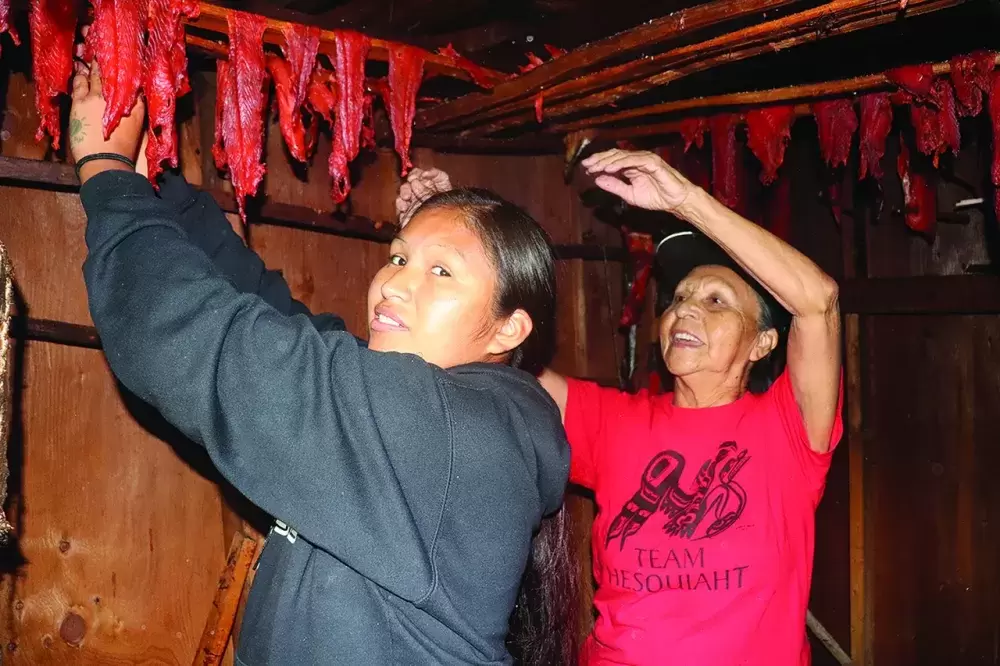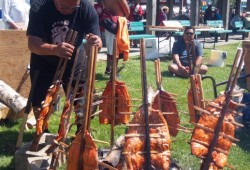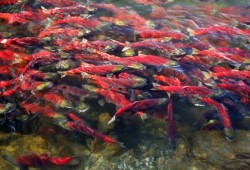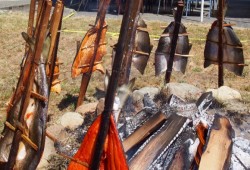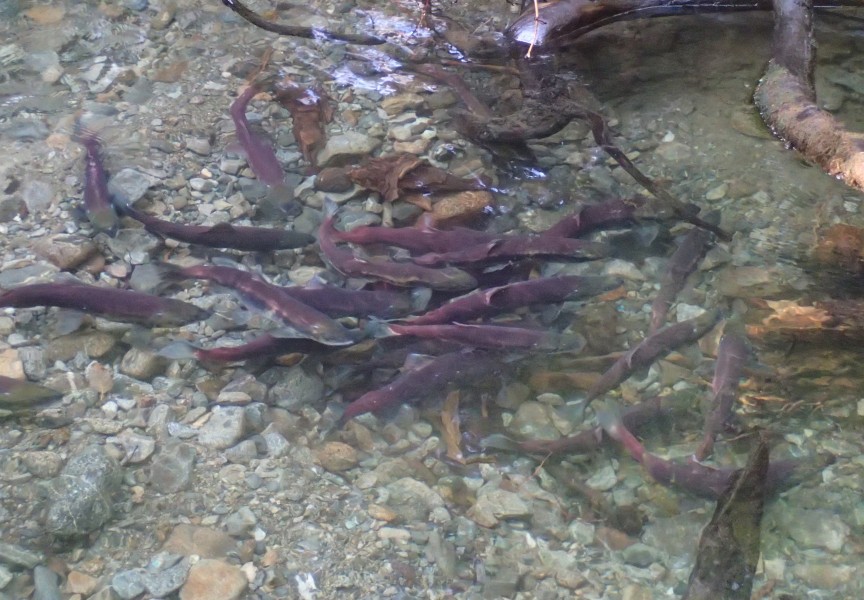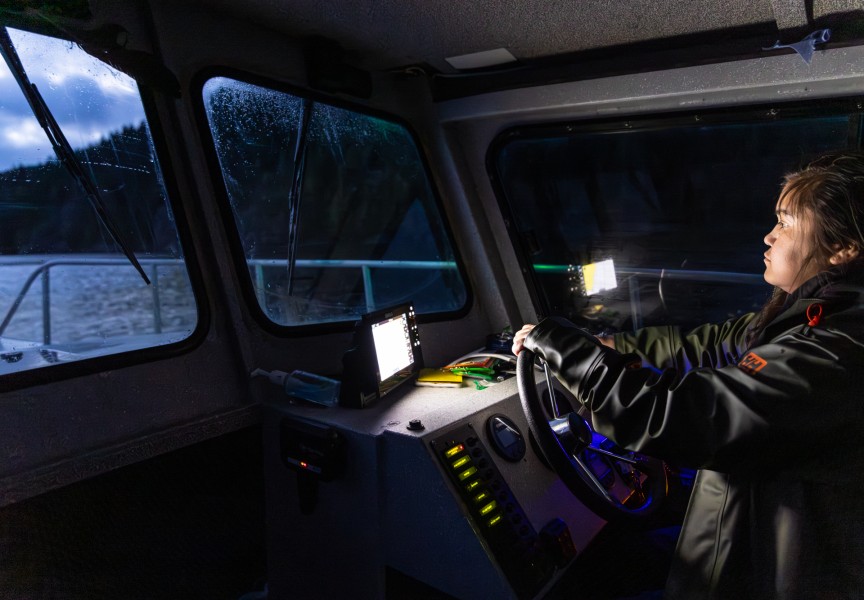Restoring salmon habitat in watersheds along the Island’s west coast could substantially boost productivity, but declining stocks won’t recover unless more spawners make it home.
Marine survival is a complex dynamic for a genus that swims many thousands of kilometres, evading predators and disease, defying odds, homing in on natal waters to die only after renewing the life cycle.
Historically there have been times when few fish returned, yet the cycle was so immutable that Indigenous people and salmonids co-evolved over millennia. Rich west coast waters rewarded both.
Judith Sayers, NTC president, recalled a Hupacasath story of two hunters who cornered a huge bird. They spared the bird when it granted them one wish: “We always want to have salmon.”
“We’ve always had salmon returning to our territories,” Sayers said, explaining the interrelationship. “I think that big bird has returned its promise.”
There are tough decisions ahead, though, to not only sustain but rebuild the relationship amid grave environmental challenges that include ocean warming, reduced marine productivity, climate change and degraded freshwater habitat. Change has been so agonizingly slow in coming and patience is wearing thin.
In late June the First Nations Leadership Council (FNLC) called for an end to all open-net pen salmon farming in the province. Reports published by fish farm owners Mowi, Cermaq and Grieg indicated 37 per cent of salmon farms across all regions exceeded government-mandated sea lice limits, the FNLC said.
“We have known for years that open-net pen salmon farming is one of the main contributors to the massive decline in wild salmon stocks in this province,” said BCAFN Regional Chief Terry Teegee. “The federal and provincial governments have been taking a piecemeal approach to this problem, with long timeframes for transition to closed containment pens, and only in a few places. We need to end salmon farming in our open oceans now to protect both wild salmon and Indigenous ways of being from extinction.”
When 1,000 Atlantic salmon escaped from a fish farm at Shaw Point in Johnstone Strait a few weeks ago, We Wai Kai and Wei Wai Kum First Nations decided they’d had enough.
Like other coastal nations, they’ve had ongoing concerns about sea lice impacts on wild juvenile salmon migrating past fish farms. They wanted to work out a collaborative structure with the province for aquaculture in their territories similar to the one established for the Broughton Archipelago in 2018, but said the province failed to “engage substantively.” We Wai Kai and Wei Wai Kum put MOWI and DFO on notice: The fish farm must go.
“The system is broken,” said Chief Brian Assu. “We cannot stand by and wait for B.C. to implement the Declaration on the Rights of Indigenous Peoples Act, or for DFO to protect our vital resource. Our nations have a right to wild salmon and the right to make decisions about how our territory is used. We will exercise that right, starting with the site at Shaw Point.”
MOWI Inc. said it followed all reporting protocols after a “small hole” was discovered in a torn net during inspection on May 24, yet the nations maintain they were not properly notified.
“We have tried to build on the work done by nations in the Broughton Archipelago and negotiate a decision-making agreement that is based on the best science, the best data and the knowledge that our communities have, but we need B.C. to be a partner in this,” Chief Roberts said.
Fish Farms on notice
The province could hardly be accused of ignoring the file. Two years ago, they set the terms: Effective June 2022, fish farm tenures will be granted only to operators who have negotiated agreements with First Nations and proven their sites won’t adversely affect wild stocks. Ottawa, meanwhile, backtracked on its 2019 election commitment, promising only a plan for phasing out marine-based fish farms in B.C. within five years.
On the west coast, where sea lice outbreaks at fish farms led to public demonstrations last summer, scientists envision a system for ensuring migratory paths are better protected for returning salmon. A “marine connectivity corridor,” in combination with a suite of broadly collaborative approaches, is one possibility. Such corridors already exist to protect coho migration.
“The idea there is we’re trying to look after our relationship with salmon by looking after the entire life cycle,” said Eric Angel, NTC fisheries manager. “We want to be concerned with every part of the journey.”
To him, it seems “dreadfully obvious” the status quo has failed salmon and people alike: “In the space of a couple of centuries, we’ve managed to wipe out the resource, or come close to it, and at the same time we find the conventional approach to fisheries management is acceptable?”
A resource-based harvest management system that considers fish a commodity for maximum economic exploitation is at fault, he contends.
Nuu-chah-nulth belief, in stark contrast, revolves around “hishuk’ish tsawalk,” everything is one, everything is connected. No other species exemplifies this inter-relationship quite so well as Pacific salmon. No wonder they are integral, important to every aspect of Nuu-chah-nulth life, “all along the mountains and sea.” The ritual of the first salmon, for example, ensures salmon spirits continue sending fish home.
“We are known as salmon people, whether it’s chinook, chum, coho, sockeye or pink,” said Judith Sayers, NTC president. The relationship — the culture of salmon — continued to evolve after contact as Nuu-chah-nulth engaged in commercial trading.
“And part of that culture is habitat management, hatcheries and restoration,” Sayers added, putting the relationship in contemporary terms.
A “tsawalk” approach to rebuilding stocks is expressed in a number of emerging concepts, the “salmon park” proposal being just one. Salmon parks, or “salmon forest conservation areas,” proposed by NTC for the Nootka Sound area, would expand the bounds of habitat protection and restoration to entire watersheds.
“It’s not about making parks with more places for salmon,” Angel explained. “It’s more about a holistic approach that includes employment, governance, economy, guardians and language revitalization.”
The proposal is a long-term strategy, one that could take centuries to fully restore watersheds to past levels of productivity. Ha’wiih, the hereditary chiefs of Nuu-chah-nulth, suggested the B.C. government adopt salmon parks to rebuild wild stocks elsewhere.
Two funding applications — one to the federal Justice Partnership and Innovation Program (JPIP), the other to Crown-Indigenous Relations and Northern Affairs Canada (CIRNAC) — have been made so far. Uu-a-thluk has been told to expect a response within weeks from the Justice Partnership.
“We framed (the JPIP proposal) more broadly as a project to renew Nuu-chah-nulth law as it relates to salmon,” Angel said. “It’s a neat project. Even if we don’t get the funding, we’re still going to proceed.”
Oceans forum established
Salmon parks, linked with marine corridors, could dovetail with another strategy: Working with other First Nations, such as Quatsino and the Haida, along coastal migratory corridors. With so many fisheries and related concerns in common, Nuu-chah-nulth and Haida last year agreed to work together through a new Oceans Dialogue Forum and technical committee, a partnership sparked by concern for west coast Vancouver Island chinook. A first forum scheduled for April had to be postponed due the COVID-19 pandemic.
“What could they do to help our salmon come back to us? This discussion is in the early stages,” Angel said.
A similar co-operative strategy exists for habitat restoration within Nuu-chah-nulth territory. After failing to obtain funds for their own restoration in the Sarita River, Huu-ay-aht First Nations have opted to join hands with other NTC nations to mount a group proposal for better chances of funding approval. Unfortunately, that too has been stalled by the pandemic.
While DFO talks of uniting stakeholders around a rebuilding plan for west coast Vancouver Island chinook, there remains the thorny issue of fishery allocations among various user groups, recreational, First Nations and commercial gear types. Nuu-chah-nulth, on the other hand, have proven their case in court over and over again. DFO has yet to follow suit but is reviewing its Pacific salmon allocation policy, advised that it constitutes an infringement on Indigenous rights. At the same time, DFO has opened the door to Nuu-chah-nulth assuming a lead role in a chinook rebuilding plan.
Is fishery justice at last on the horizon?
“I think it can be achieved,” Sayers said. “We have been building capacity and have shown DFO our ability, but they have to trust us. Over the years, we’ve been able to raise the profile of issues more and more, and DFO has had to start acknowledging that. We just have to keep pushing them there.”
A similar conviction echoed on the east side of Vancouver Island in June.
“For countless generations, our people have cared for, harvested and relied on salmon as they return to our local spawning grounds and as they migrate through Laichkwiltach waters to many rivers, including the Fraser,” said Chief Chris Roberts. “We are ready to exercise our right as decision makers and stewards over our lands and waters. We hope that government will partner with us in a meaningful way to achieve real progress.”

